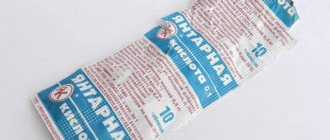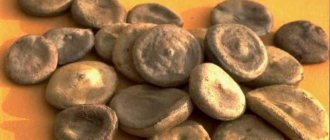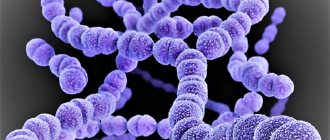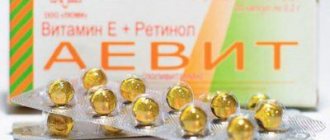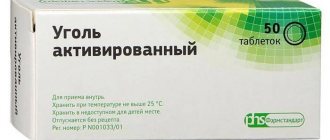Glycine is an organic compound - a non-essential amino acid. The compound is part of a large number of proteins and bioactive chemical compounds synthesized by different cells of the body.
In the normal state of the human body, this compound is independently synthesized by tissue cells.
Additionally, a certain amount of the substance enters the body in food.
Glycine has a number of positive properties:
- anti-inflammatory effect;
- stimulation of synthesis processes of basic enzymes;
- stimulating the production of neurotransmitters required for normal brain function;
- helps slow down the processes of muscle tissue degeneration;
- helps support the functioning of the thymus gland;
- promotes normal functioning of the bone marrow and spleen;
- takes part in the production of blood cells.
If there is a deficiency of this compound in the body, it can be replenished by taking medications containing artificial glycine.
This substance is synthesized using two reactions:
- by using hydrolysis.
- Using chemical synthesis.
When using the second method, glycine is formed in the form of a white powdery mass. The powder is odorless and has a sweetish taste. The compound gets its name due to its sweet taste. Glycys is translated from Greek as “sweet”.
The use of glycine can significantly reduce cravings for alcoholic beverages and is very helpful in case of a hangover.
A sufficient amount of glycine in the body prevents large-scale destruction of brain cells.
The presence of glycine in the body can have benefits and harm, it all depends on the amount of this amino acid in the body.
Useful properties of glycine
The product has a number of useful properties:
- reduces aggressiveness,
- normalizes sleep,
- improves memory,
- reduces disorders resulting from a heart attack or stroke,
- alleviates the condition of intoxication,
- improves performance.
The benefits of glycine as a medicine for the prevention of various diseases are undoubted.
- Taking glycine helps lower blood pressure levels, which is one of its most outstanding properties.
- The benefit of glycine also consists in reducing vegetative-vascular manifestations, including during menopause.
- Interestingly, glycine is a popular recovery aid for athletes between workouts.
- Glycine has been noted to be beneficial as a means to improve metabolism in the brain.
Important! A positive effect from taking it is observed only when pathological changes are diagnosed. The benefits of glycine for a healthy person’s body are determined individually in each case.
Benefits of glycine for men
The product has become quite widespread due to its effectiveness in eliminating problems caused by sexual dysfunction in men. Prescribed by the attending physician if it is determined that potency problems are associated with a psychological disorder or trauma. The benefit lies in removing toxins from the body, relieving psychological stress before sexual intercourse, and strengthening the walls of blood vessels.
To increase potency, glycine must be taken in full for the beneficial effect to be maximum.
Attention! This medication is not a treatment for impotence and is not intended to completely eliminate all sexual problems in men.
Is glycine good for breastfeeding?
During breastfeeding, aminoacetic acid, due to its beneficial properties, has a positive effect on the processes occurring in the body of a nursing mother. Metabolism is normalized, cognitive processes are improved, and there is also benefit in regulating the rhythms of sleep and rest.
It is recommended to coordinate the treatment course with your doctor. Pediatricians prescribe glycine to children under 1 year of age and nursing mothers. This is explained by the absence of proven harm to the body of the mother and child, its production from plant materials and only a small amount entering colostrum and breast milk.
Is it possible for infants?
At the age of up to 1 year, pediatricians allow children to take the drug in the following cases:
- sleep problems;
- birth injury;
- hyperactivity.
Babies are not able to swallow a tablet, so they are advised to give them powder diluted in water. You can also crush ½ tablet and stir it in water until completely dissolved. The maximum duration of the course is 1 month, after which the doctor will be able to determine the level of positive effects of the substance on the body.
What are the benefits of glycine for children?
Restlessness and anxiety are quite common phenomena in schoolchildren and preschoolers due to the characteristics of children's physiology and psychology. Regular intake of a neurotransmitter amino acid can help a child painlessly endure changes in situation and environment and cope with stress. This is the undoubted benefit of glycine for children.
Quite often, this neurotransmitter is prescribed to hyperactive, absent-minded teenagers. Taking the drug improves concentration and makes it easier to memorize material, which has a positive effect on academic performance.
Glycine for babies
The drug is prescribed to an infant in the following cases: identification of birth trauma, overexcitation, sleep disturbance.
Due to the fact that independent resorption of the tablet form by infants is not possible, half the tablet must be crushed to obtain a powdery mass, then dissolved in water at room temperature. Dissolution does not affect the properties. In this case, the duration of treatment can be up to 4 weeks - this will allow you to evaluate the beneficial effect. Possible harm is assessed by the attending physician: as a rule, it is unlikely, and the potential benefits are much higher than the risks.
Where to buy supplements
A drug based on aminoacetic acid can be purchased at a pharmacy. However, it costs a lot of money. We recommend ordering it on the iHerb website, since this online store offers drugs at low prices from premium manufacturers such as Solgar, Now Foods, etc. Here you can also choose a convenient delivery method, read product reviews and ask for help to the support service.
★★★★☆
Now Foods, Taurine, Double Strength, 1000 mg, 100 Vegetarian Capsules
572 ₽
★★★★☆
Now Foods, Taurine, Double Strength, 1000 mg, 250 Veggie Caps
1 145 ₽
★★★★★
Now Foods, Taurine, 500 mg, 100 Capsules
352 ₽
★★★★☆
Doctor's Best, NAC Detox Regulators, 60 Vegetarian Capsules
504 ₽
★★★★☆
Doctor's Best, N-acetylcysteine to regulate the detoxification process,…
1 235 ₽
★★★★☆
Optimum Nutrition, Superior Amino 2222 Tabs, 320 tablets
1 957 ₽
Glycine is beneficial for the body, because its deficiency affects overall health. The lack of this substance provokes deterioration of memory and functioning of the central nervous system, manifested by fatigue and insomnia. If such symptoms appear, it is advisable to immediately consult a doctor and also get tested for the content of aminoacetic acid in the body.
Dosage and rules for using glycine
Glycine is prescribed individually by the attending physician, after assessing the potential benefits and harms of the drug for a particular patient.
The standard dose is 1 tablet 2-3 times a day, and the course of treatment (depending on the diagnosed pathology) can range from 1 week to 1 month and can be carried out several times a year, the interval between courses can be 30 days.
For sleep disorders, for maximum benefit, aminoacetic acid is taken half an hour before bedtime or immediately before falling asleep, 0.5–1 tablet (dosage depends on age).
The drug is used in tablets or crushed to powder form sublingually (placed under the tongue) or buccally (between the lip and jaw or in the oral cavity until final resorption). The beneficial properties of the neurotransmitter manifest themselves equally with any method of administration.
How to drink glycine for adults
The benefits of glycine for the adult body are known.
In case of traumatic brain injuries and ischemic strokes, it is advisable to start taking the neurotransmitter immediately, even before the manifestations of the disease disappear. The recommended useful dose for ischemic stroke is 10 tablets within 3-6 hours after the first manifestation of symptoms of the disease. The first five days after a stroke you should take 10 tablets, then 3 a day for a month.
For insomnia, the drug is taken half an hour before bedtime or immediately before bedtime.
For chronic alcoholism or drug addiction, take 2-3 tablets. per day for 4 weeks.
Cardiologists have also proven the value of aminoacetic acid. For the prevention of heart pathologies, the benefits of glycine are unconditional: it is dissolved in 1 tablet. in a day.
How to take glycine for children
Before use, consultation with a specialist is required, since, despite the general benefits of aminoacetic acid, the risk of individual intolerance cannot be excluded. For this reason, you should not carry out treatment yourself.
The recommended norm for children with reduced performance, deviations, and developmental delays is 2–3 tables. 2–3 times a day. The course of treatment ranges from 2 weeks to 1 month. Children under 3 years of age are prescribed 50 mg (instead of 100) per day.
If the drug is needed by an infant who has problems taking pills, then it is prescribed to the mother so that aminoacetic acid enters the baby’s body through breast milk.
How much glycine can you drink per day (daily value)
The most popular regimen for using the drug is 1 or 2 tablets 2-3 times a day. If you have sleep disturbances, even 1 tablet will be useful. The daily dose depends on a number of factors, including the age of the patient and the type of disease. Taking 6 tablets (2 tablets after meals) is acceptable after traumatic brain injury or alcohol poisoning.
Advice! A person experiencing severe stress is allowed to take 2-4 tablets at a time; it will not cause harm.
What is it needed for?
The drug inhibits the secretion of certain amino acids by brain neurons, having a calming effect on the nervous system. Indications for the use of glycine in neurology are the following disorders:
- sleep disturbance;
- infectious diseases of the central nervous system;
- frequent depression, mental and nervous stress;
- neuroses;
- aggressive behavior and overexcitability in childhood;
- memory problems;
- decreased ability to work due to neurological disorders;
- recovery of the body in the postoperative period;
- concussion and traumatic brain injury;
- stroke;
- epilepsy.
The causes of frequent headaches can be various diseases of the cardiovascular and nervous system, as well as mental and physical overstrain. Neglecting treatment can lead to migraines. With this pathology, attacks of pain appear up to 8-10 p.m. per month and do not stop for 2-3 days. Additionally, the patient complains of tinnitus, insomnia, irritability, tingling in the temples, drowsiness, nausea and vomiting.
Glycine has a sedative effect and helps relieve symptoms. A person’s sleep is normalized, mood improves and aggression decreases. Prophylactic use of the drug prevents the occurrence of psycho-emotional disorders, due to which the number of attacks is reduced.
The medication is also recommended for patients with heart disease (arrhythmia, tachycardia, hypertension), which often occurs as a result of interruptions in the functioning of the central nervous system and are accompanied by insomnia. Taking an amino acid helps normalize sleep, reduce heart rate and dilate blood vessels, which increases blood flow to organs and lowers blood pressure. When treated with this drug, the number of hypertensive attacks in patients is significantly reduced. For hypertension, it is taken together with other medications, as it has only a short-term hypotensive effect.
Important: Glycine increases blood pressure only during hypotension caused by VSD. Therefore, hypotensive patients can take it after prior consultation with a doctor.
But not only sick people use the drug. Knowing the beneficial properties of glycine, you can understand why it is useful for athletes. Proper use of amino acids helps to increase the body's endurance, activate metabolism and gain muscle mass. At the same time, athletes should not exceed the established dosage, since in excess glycine begins to displace glucose, which will lead to a decrease in energy production.
Cosmetologists use glycine as an antioxidant, which removes harmful substances from the body and slows down the aging process. It is added to creams, lotions and gels. Such skin products increase its elasticity, moisturize and help smooth out fine wrinkles on the face. The substance is often included in shampoos or conditioners, which, when used, make hair silkier and shinier.
Another beneficial property of the amino acid is considered to be weight loss by stabilizing the “hunger-satiety” process and increasing the production of enzymes that promote the breakdown of fat.
Why does glycine deficiency occur?
Lack of glycine in the body is a common phenomenon. Amino acid deficiency affects primarily the nervous system.
Main reasons:
- suffered stress,
- high physical and mental stress,
- lack of sleep,
- bad habits.
Passion for vegetarianism also leads to amino acid deficiency and, as a result, to a decrease in muscle mass and anemia. However, a careful and competent selection of healthy products will help solve problems with obtaining the elements necessary for full life.
Composition and properties of the drug
Glycine is a drug that improves brain metabolism
Glycine is a nonessential amino acid that is constantly present in the human body. It is produced by the body in a certain amount. Additional intake of the drug is required only if there is not enough of its own amino acid, which leads to nervous disorders. Glycine is a neurotransmitter, that is, it is responsible for the conduction of nerve impulses.
Your doctor will tell you how to take Glycine, whether it will cause harm or benefit in the end. Most often, in addition to glycine itself, the composition includes various auxiliary substances. Sometimes B vitamins are added to the drug.
Glycine performs the following roles in the body:
- Removes toxins. Glycine is responsible for removing harmful substances from the body. It is this property that allows the substance to be used for the treatment of alcoholism. It reduces the toxicity level of ethyl alcohol.
- Inhibits neural cells. Glycine has an inhibitory effect on neuronal cells, reducing their production of excitatory amino acids, which has a calming effect on the nervous system.
- Normalizes the body's absorption of iron and calcium. Glycine reacts with these substances and improves their absorption by the body.
- Inhibits central nervous system processes. Glycine relieves irritation, depressive and aggressive conditions due to the fact that it inhibits nervous processes.
- Glycine is considered a fairly safe drug. When taken correctly, it does not harm the body. Glycine is often used in the food industry as a sugar substitute.
The drug is available in the form of tablets for sublingual resorption. It is stored at a temperature not exceeding 25 degrees and is sold without a prescription. The shelf life is 3 years from the date of manufacture of the drug.
Glycine is also present in some foods, for example, ginger, nuts, quail eggs, greens, kiwi, bananas.
A lack of glycine leads to a person becoming more irritable, sleeping poorly, and suffering from lack of concentration.
Consequences of glycine overdose
Despite the non-toxicity of glycine and the ability to be excreted naturally, its abuse can lead to some harm. Most often, such cases occur with children who are attracted by the sweet taste of aminoacetic acid.
With an overdose of glycine (more than 3 g per day), an increase in its sedative properties is observed.
Symptoms:
- dizziness,
- nausea,
- general weakness,
- drowsiness,
- blood pressure decreases.
If you have hypersensitivity or a predisposition to allergies, redness of the skin, eyes, runny nose, and diarrhea may occur.
Attention! If these signs appear, it is necessary to immediately stop taking the drug, drink plenty of fluids and consult a doctor.
First aid to the victim
You can help a person taking glycine when an overdose of the drug is obvious, as follows:
- Rinse the stomach, usually incoordination begins approximately 40-50 minutes after taking the drug, so its remnants that have not yet dissolved in the blood must be urgently removed.
- After the water from the stomach becomes relatively clean, give sorbents, the same coal, although there is little benefit from it in case of glycine poisoning, but coal will help the liver and kidneys cope with the negative effects.
- Take invasive medications.
- Provide plenty of fluids, horizontal position and fresh air.
Doctors who arrive on call hospitalize those poisoned by this drug only when the body is under threat of lactic acidosis coma. However, you cannot neglect calling doctors. Because it is simply impossible to independently determine the severity of the patient’s condition and assess the harm caused by the drug.
In order to reduce the risk of such situations, you need to remember to consult with specialists before starting to take the medicine. And of course, follow the recommended dosage.
Video: amino acid glycine.
Contraindications and side effects from taking glycine
The drug has virtually no contraindications: its properties are identical to the amino acid that is produced in the human body. There were also no cases of poisoning with the drug. Side effects are recorded extremely rarely: mainly, fatigue, allergic manifestations, drowsiness, and low blood pressure. If one of these signs appears, you should immediately consult a doctor to minimize possible harm.
Amino acid deficiency - why is it dangerous?
All amino acids can be divided into three types:
- Essential: amino acids that cannot be produced by the body and must be obtained through separate sources, such as following a special diet and including foods containing certain amino acids in the daily diet.
- Nonessential: These amino acids can be obtained by the body from other amino acids. And they are produced by the body independently.
- Conditional: Amino acids that the body can produce but will not necessarily supply in sufficient quantities (especially during times of stress, illness, or injury). Thus, consuming them through dietary sources may be required.
Glycine is made from the essential amino acids serine and threonine. It belongs to the conditional category. However, some research suggests that the human body is not able to create enough glycine on its own.
The results of a serious imbalance in amino acids can lead to health problems. Although extreme glycine deficiency is as rare as its excess, insufficient levels of this amino acid lead to depression, neuroses, joint fragility, and restless sleep.
And so, the positive and negative sides of Glycine were described here. In addition, very often it is used for insomnia, although this drug most often actually relieves symptoms. In another case, when the result is unsatisfactory, many increase the dosage and are extremely surprised when side effects appear.
Glycine is a non-essential amino acid. The substance is present in various proteins and biologically active compounds in the body. Under normal conditions, this amino acid is produced by the human body, but some amount is also obtained from food. Artificial glycine is created through two reactions: through hydrolysis - interaction with water and through chemical synthesis. In the second case, a white powdery substance is formed. It is odorless and has a sweetish taste, which is how the amino acid got its name: glycys means “sweet” in Greek.
Is glycine compatible with alcohol?
Taking glycine helps speed up metabolism and eliminate toxins formed under the influence of ethyl alcohol. The neurotransmitter is used both in chronic alcoholism and in the severe consequences of binge drinking as an adjuvant, as well as to eliminate hangover syndrome. A beneficial effect is observed after dissolving two tablets. A maximum of 4 such doses are allowed per day.
Warning! An overdose of neurotransmitters when drinking alcoholic beverages is harmful, as it increases intoxication.
What foods contain glycine?
Products that contain protein contain glycine. Protein contains:
- meat, fish products,
- liver;
- cottage cheese;
- eggs;
- gelatin-containing products: jelly, marmalade, jelly;
- legumes: soybeans, lentils, peas, chickpeas, beans;
- nuts:
- sunflower seeds
Pasta, bread, and cereals are rich in amino acids: buckwheat, oatmeal, pearl barley. A person should consume 4-7 g of useful amino acid per day. The human body is able to produce approximately 3 grams on its own, and receives about 2 g from food. The need to take amino acids increases if there is heavy physical or mental stress, injury, or cardiovascular problems.
Glycine analogues
Glycine has analogues with similar beneficial effects and properties. They contain other active ingredients, but the principle of their action is generally the same.
The most popular neurotransmitter analogs:
- Mexidol. Used to improve brain function and is effective in combating withdrawal symptoms.
- Tryptophan. Recognized as useful in the treatment of depressive disorders, reduces the harm and severity of alcohol withdrawal.
- Neurotropin. Used for dyscirculatory encephalopathy, its benefits for reducing anxiety levels have been proven.
The benefits and harms of each of the above-mentioned analogs should be assessed solely on an individual basis, taking into account the diagnosis, the degree of disorders, concomitant pathologies, as well as the properties of other medications taken.
Reviews
Mikhailov Igor, 60 years old, Kaluga I regularly take glycine after suffering an ischemic stroke. An excellent set of properties for a seemingly simple medicine! It relieves anxiety and headaches quite well, and was useful for my wife with blood pressure surges. After taking glycine, my sleep also returned to normal. Maria Belyaeva, 35 years old, Chita The use of glycine for children is an indispensable way to improve school performance and combat stress. I was convinced by the example of my own child. I recommend it for use. I didn’t notice any harm – the beneficial properties are obvious! Yulia Denisova, 30 years old, Moscow One of my children is 2 years old, I give glycine from an early age on the recommendation of a pediatrician. I was worried about possible harm, but the product effectively copes with agitation and sleep disturbances. At the age of six months, my daughter became anxious and cried often - I started taking glycine myself, it is well transmitted to children through breast milk. Glycine for infants is an ideal sedative, and there is no problem of addiction.
Did you find this article useful? Not really

